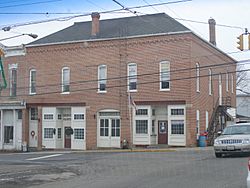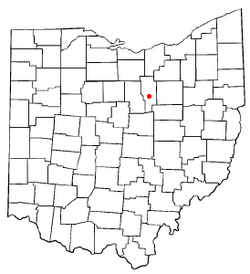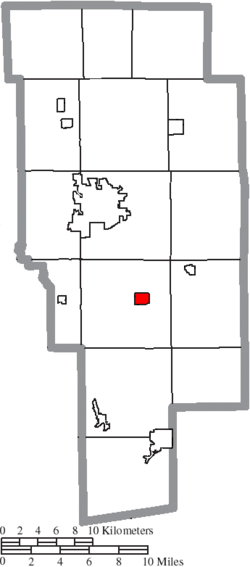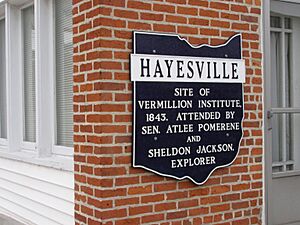Hayesville, Ohio facts for kids
Quick facts for kids
Hayesville, Ohio
|
|
|---|---|
|
Village
|
|

Village Hall
|
|

Location of Hayesville, Ohio
|
|

Location of Hayesville in Ashland County
|
|
| Country | United States |
| State | Ohio |
| County | Ashland |
| Township | Vermillion |
| Area | |
| • Total | 0.74 sq mi (1.92 km2) |
| • Land | 0.74 sq mi (1.91 km2) |
| • Water | 0.00 sq mi (0.01 km2) |
| Elevation | 1,217 ft (371 m) |
| Population
(2020)
|
|
| • Total | 447 |
| • Estimate
(2023)
|
443 |
| • Density | 605.69/sq mi (233.88/km2) |
| Time zone | UTC-5 (Eastern (EST)) |
| • Summer (DST) | UTC-4 (EDT) |
| ZIP code |
44838
|
| Area code(s) | 419 |
| FIPS code | 39-34636 |
| GNIS feature ID | 2398270 |
Hayesville is a small village located in Ashland County, Ohio, in the United States. It is part of Vermillion Township. In 2020, about 447 people lived there.
Contents
History of Hayesville
The land where Hayesville now stands was first owned by a person named Lemuel Boulter. He later sold his part of the land to Linus Hayes. The very first people to settle in this area arrived in 1817.
A post office was set up for the settlers in 1827. It was located at a place called Hayes Cross Roads. The village of Hayesville was officially planned out in 1830. Its plots were recorded in Mansfield, Ohio on October 26, 1830.
The village was named after Linus Hayes, who owned the land. Hayes Cross Roads later became known as Hayesville. The village officially became an incorporated village in 1849. This means it became its own legal town.
Geography of Hayesville
Hayesville is a small village in Ohio. According to the United States Census Bureau, which collects information about places, the village covers a total area of about 0.74 square miles (1.92 square kilometers). All of this area is land.
Who Lives in Hayesville?
This section shares information about the people who live in Hayesville. This data comes from official counts called censuses.
| Historical population | |||
|---|---|---|---|
| Census | Pop. | %± | |
| 1850 | 441 | — | |
| 1860 | 336 | −23.8% | |
| 1870 | 576 | 71.4% | |
| 1880 | 563 | −2.3% | |
| 1890 | 430 | −23.6% | |
| 1900 | 332 | −22.8% | |
| 1910 | 338 | 1.8% | |
| 1920 | 247 | −26.9% | |
| 1930 | 382 | 54.7% | |
| 1940 | 363 | −5.0% | |
| 1950 | 381 | 5.0% | |
| 1960 | 435 | 14.2% | |
| 1970 | 506 | 16.3% | |
| 1980 | 518 | 2.4% | |
| 1990 | 457 | −11.8% | |
| 2000 | 348 | −23.9% | |
| 2010 | 448 | 28.7% | |
| 2020 | 447 | −0.2% | |
| 2023 (est.) | 443 | −1.1% | |
| U.S. Decennial Census | |||
What the 2010 Census Showed
In 2010, the census counted 448 people living in Hayesville. There were 184 households, which are groups of people living together. Out of these, 135 were families.
The population density was about 605 people for every square mile. This means how many people live in a certain area. Most of the people living in the village were White (98.4%). A small number were Asian (0.2%) or from two or more races (1.3%). About 0.4% of the population was Hispanic or Latino.
About 31% of the households had children under 18 living with them. Most households (61.4%) were married couples living together. Some households had a female head (8.2%) or a male head (3.8%) without a spouse. About 26.6% were not families.
The average household had 2.43 people. The average family had 2.84 people. The median age in the village was 42.8 years old. This means half the people were younger and half were older than this age.
About 23.7% of residents were under 18 years old. About 17.9% were 65 years or older. The village had slightly more males (52.2%) than females (47.8%).
Famous People from Hayesville
- Ralph Eugene Diffendorfer was a Methodist clergyman. A clergyman is a leader in a Christian church. He helped design the Christian flag.
See also
 In Spanish: Hayesville (Ohio) para niños
In Spanish: Hayesville (Ohio) para niños


